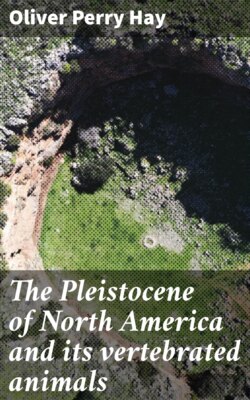Читать книгу The Pleistocene of North America and its vertebrated animals - Oliver Perry Hay - Страница 70
Mastodons Found in the Unglaciated Region.
Оглавление1. Posey County.—On page 341 of Blainville’s “Ostéographie des Mammifères,” volume III, it is stated that Lesueur had shown Blainville drawings of a fine vertebra and a femur, with its epiphyses, of a mastodon which had been found along the Wabash River. His language indicates that this was somewhere below New Harmony. He stated that these bones were in the library at Vincennes, Indiana. In answer to my inquiry about these bones, President Horace Ellis, of Vincennes University, informed me that some bones which appear to be those mentioned are in his university.
These remains were found in digging a well, at a depth of 60 feet. One of the curators of the library at Vincennes, Mr. Badollet, states that with these bones were some skin and hair. We may suppose that there was some mistake about this.
Unfortunately, as in so many other cases, it is now impossible to determine just where these remains were found. New Harmony is situated on the border of the Illinoian drift, and this continues nearly 10 miles farther south. This drift is covered by loess. A well sunk here would, at a depth of 60 feet, be in probably Iowan loess. Nearer the river, in the lowlands, the depth given would probably be in Wisconsin outwash.
2. Dubois County.—Some details regarding the specimen found here are given in the author’s paper on the “Pleistocene of Indiana” (36th Ann. Rep. Geol. Surv. Indiana, p. 702). A part of a mastodon was found long ago near the mouth of Wolf Creek, at the Rock House Ford of White River. This appears to be in Harrison Township (1 north, range 4 west). The valley of White River is here occupied by alluvial terraces older than the Wisconsin drift (Leverett, Monogr. XXXVII, U. S. Geol. Surv., plate VI). There is here too, no doubt, much outwash from the Wisconsin glacier itself.
The writer has received a photograph of a mastodon tooth which Mr. Marshall Roberts, of Jasper, Indiana, found in 1912 in East White River, in the northwest part of Harrison Township. The tooth is 195 mm. long and 87 mm. wide and has four crests and a large talon.
In Samuel L. Mitchill’s “Observations on the Geology of North America,” page 363, it is stated that a part of a mastodon had been found, in July 1817, “near the falls of the east branch” of White River. No exact conclusion can be drawn from the facts known.
3. Hindostan, Martin County.—Mastodon remains (36th Rep. Geol. Surv. Indiana, p. 707) have been found at Hindostan, on the east bank of White River, about 4.5 miles directly southwest of Shoals. A mastodon tooth was found in White River at Shoals (op. cit., p. 709). It appears to be impossible to determine the age of this material.
4. Orange County, west of Orleans.—The writer has given an account (36th Rep. Geol. Surv. Indiana, p. 710) of mastodon remains found here, on the farm of Mr. Marion F. Mathers, apparently near the line between the townships of ranges 1 and 2 west and 3 north, and about 2 miles south of the line between Orange and Lawrence Counties. The remains appear to have been found in a valley and about 4.5 feet below the surface. Being found thus in an unglaciated region, they might have been deposited at any time during the Pleistocene.
5. Sparksville, Jackson County.—Some years ago teeth and ribs of a mastodon were found on the bank of White River, at Sparksville. The valley here is filled with outwash from the Wisconsin drift, but there is possibly some outwash from the Illinoian.
6. Jackson County, 7 miles west of Tampico.—(See 36th Ann. Rep. State Geologist of Indiana, vol. XXXVI, p. 706.) A mastodon tooth was reported found on the bank of Judah Creek, a branch of Mill Creek, in section 9, township 4 north, range 4 east, not far from Muscatatuk River. This is at some distance outside of the border of the Illinoian drift. Along Mill Creek are alluvial deposits, but nearby is Chestnut ridge of probably Wisconsin age (32d Ann. Rep. Geol. Surv. Indiana, p. 192).
7. New Albany, Floyd County.—In the Fifth Annual Report of the Geological Survey of Indiana, page 176, Mr. William W. Borden stated that mastodon remains had been frequently found on the bank of the Ohio River, at New Albany. As too often, there are lacking details as to localities and levels. It is quite probable that there is some outwash at this place from the Illinoian drift, and there is much from the Wisconsin.
